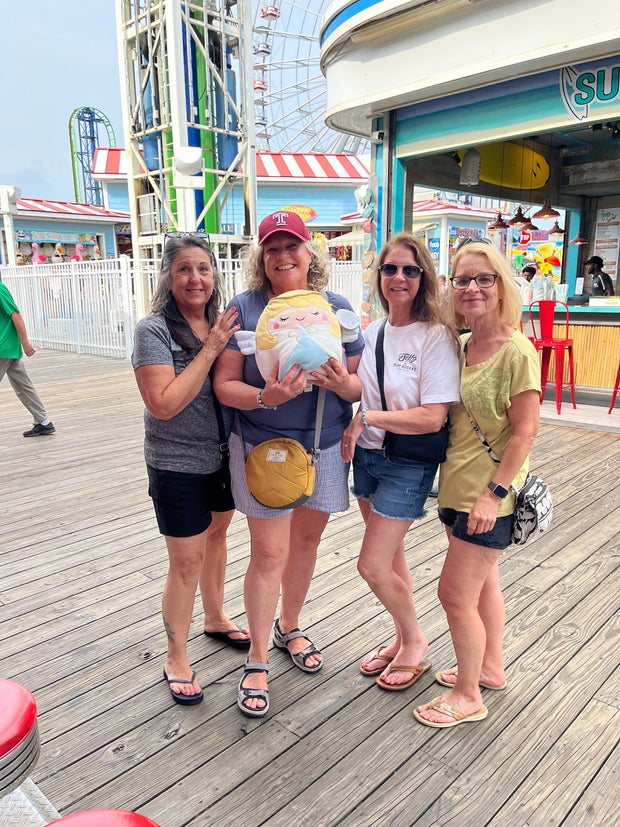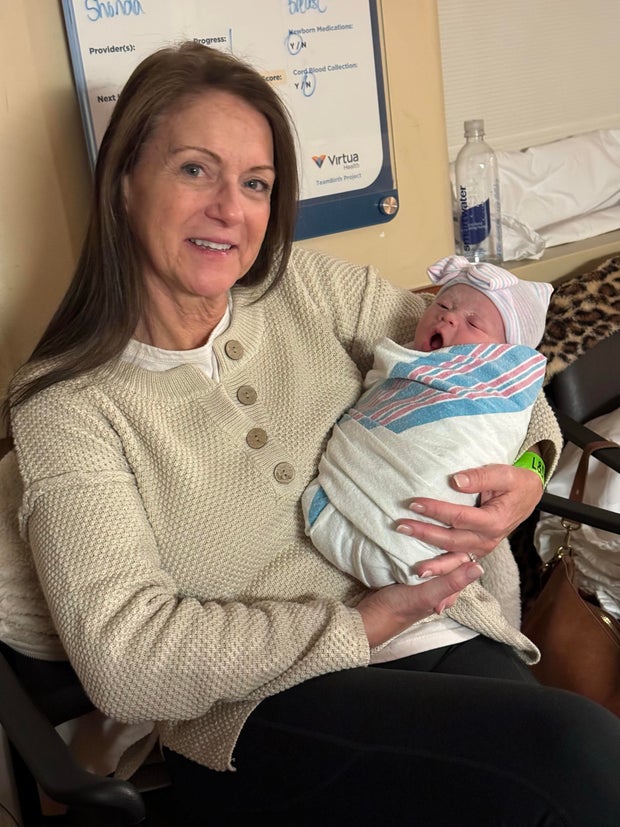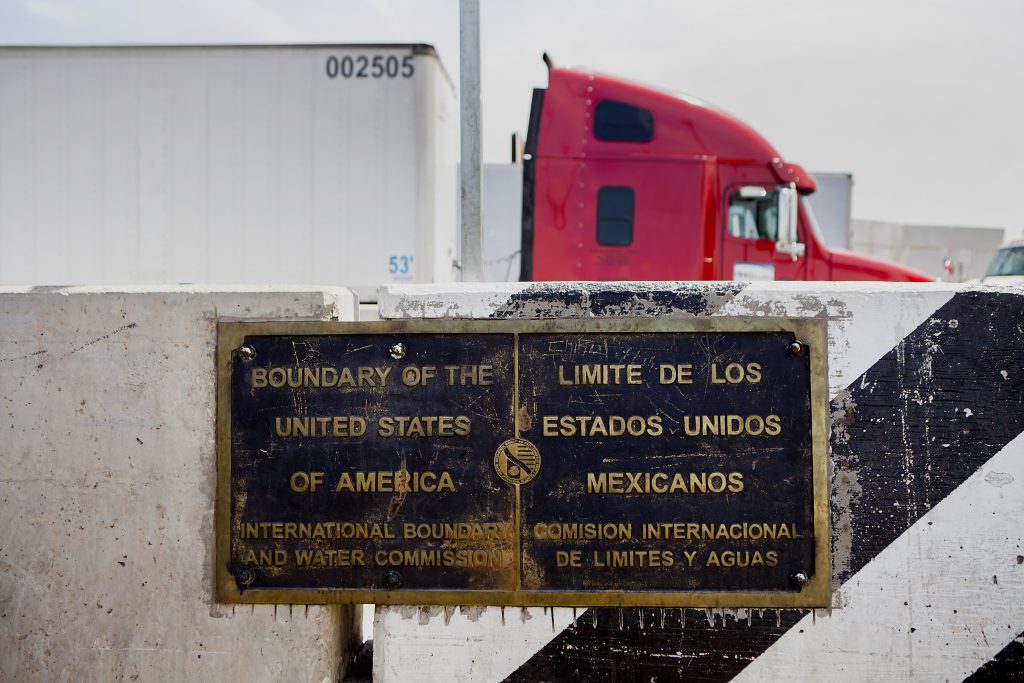Last January, Allison Ciaccio had a respiratory illness she couldn’t get over. Over-the-counter medications didn’t help. An antibiotic from her doctor didn’t either. After a month of symptoms, Ciaccio’s daughter recommended she go to the emergency room.
A chest X-ray showed that Ciaccio might have pneumonia, but there was a suspicious blot on the X-ray that her doctor wanted to follow up on. Treatment for pneumonia didn’t do much to alleviate her symptoms. At the end of March, she underwent a CAT scan that showed a “highly suspicious lesion” on one lung. Ciaccio’s primary care physician recommended she see a specialist.
Ciaccio said the call, which came on Good Friday, sent her into a “meltdown.” Even before an official diagnosis, she feared the worst. Her daughter was expecting a baby, which would be Ciaccio’s first grandchild, and the thought of missing out on time with her growing family was devastating.
“I was in total disbelief. It was A to Z in literally 30 seconds, all that emotion,” Ciaccio, now 65, recalled. “Here’s my first grandchild coming. All the years I’ve been here, and now I have something so wonderful to look forward to, and I have this. Is this going to take me away from that? Is it life-ending? You just don’t know.”
Ciaccio went to a pulmonologist and underwent a PET scan, which uses a radioactive tracer to search for traces of cancer. The scan found signs of cancer, and a biopsy confirmed that she had lung cancer. The diagnosis was a shock to Ciaccio, who considered herself healthy and had never smoked.
“I still can’t grasp the fact that I have a cancer diagnosis, or had a cancer diagnosis,” Ciaccio said. “I didn’t think it would be me, and of all things, I’d never thought lung cancer. My mom had breast cancer, so in the back of my mind I thought ‘Well, if I’m ever going to have cancer, it’ll be breast cancer.’ I never expected lung cancer.”
Lung cancer in “never-smokers”
Ciaccio was shocked to be diagnosed with lung cancer because she had never smoked, but Dr. Jonathan Villena-Vargas, a thoracic surgeon at NewYork-Presbyterian and Weill Cornell Medicine, who was not involved in Ciaccio’s care, said it’s more common than people might expect. “Never-smokers” account for about 20% of the 250,000 new lung cancer diagnoses each year, Villena-Vargas said.
Environmental factors, like exposure to radon gas and other chemicals like asbestos, and genetic conditions are most likely to be the cause of lung cancer in never-smokers, he said. Ciaccio said she’s still unsure what caused her own illness.
Lung cancer is the deadliest cancer each year, according to Villena-Vargas and statistics shared by the National Cancer Institute. Villena-Vargas said that if lung cancer in never-smokers was treated as its own category, it would be among the top 10 deadliest cancers.
“There’s no real data regarding which one is deadlier. The only thing that can make it less deadly is if it’s caught earlier,” Villena-Vargas said. “In reality, it’s harder to catch lung cancer in a never-smoking population, because they don’t have that risk factor of smoking. A lot of these patients are found incidentally, and unfortunately, that leads us to catch it at a later stage.”
Ciaccio’s case is one of those incidental discoveries. Luckily, her cancer was caught at Stage I, giving her better chances for successful treatment and recovery.
“Thank God I got sick and went to a doctor because I didn’t have any symptoms that would have taken me in for any other reason,” she said.
Using robotic surgery to reduce recovery times
Ciaccio planned to receive care for her lung cancer in Princeton, New Jersey, but a friend advised her to see Dr. Robert Cerfolio at NYU Langone. For decades, Cerfolio has used robotic surgery to treat patients. He estimated that he’s conducted over 3,000 such operations.
The surgery allows surgeons to use a robotic system to make several small incisions between a patient’s ribs, Cerfolio said. The surgeon sits at a console during the process, while a high-definition camera placed through one of those incisions provides a view of the chest cavity. Tiny robotic instruments, which Cerfolio described as being about a half-inch in size, are inserted through the incisions. Those instruments are controlled from the console. They can be used just like a scalpel or other tool would be, but on a much smaller scale, Cerfolio said.
Cerfolio said the tiny instruments allow for more precise movement, and that patients who undergo robotic surgery have a lower risk of bleeding or other complications. The robotic surgery option also means a surgeon doesn’t have to go through a patient’s ribs to operate. The small incisions result in less pain and recovery time for patients, Cerfolio said, and it allows them to get back on their feet faster.
Cerfolio proposed that Ciaccio undergo a robotic left upper lobectomy, which would take about half of her left lung. She signed up for the surgery that day. Her operation went well. In addition to the piece of her lung, Cerfolio wound up removing 25 lymph nodes. She went home the next morning, as scheduled. Her cancer was caught early enough that she didn’t need to undergo chemotherapy or radiation.
Enjoying life after surgery
In the eight months since her surgery, Ciaccio has had multiple follow-up appointments. She’s stayed in close contact with Cerfolio and his team and is seeing a local pulmonologist to make sure her lung function is recovering. She has also had follow-up appointments to make sure her cancer hasn’t come back.
“I keep having these angels cross in front of my path and help guide me down this journey,” Ciaccio said. “I feel like I’m in good hands all the way around.”
Now, Ciaccio said she’s been trying to live in the moment and enjoy life — which means spending plenty of time with her daughter and granddaughter. She’s cutting back on her hours at the orthopedic office where she works, and plans on getting into pickleball with her husband.
“This grandbaby is just overwhelming and I can’t get enough of her. That’s my focus,” Ciaccio said. “When you’re getting older, and you get presented with something like this, you sometimes have to refocus on what’s really important moving forward. I have all intention of being here 20 more years, so I need to do whatever I need to do to achieve that.”



